by Amineddoleh & Associates LLC | Jan 23, 2024 |
Our firm is thrilled that this is Master Drawing New York’s (MDNY’s) first year with our client, Christopher Bishop Fine Art, at the helm. This highly-anticipated, week-long event is the premiere art exhibition of works on paper in the United States. Over two dozen galleries on the Upper East Side will feature rare and exquisite works on paper, in addition to some paintings, sculptures, and photographic works. The selected works range in date, with some pieces dating back to the 15th century.

Brochure cover for MDNY 2024. Image via Master Drawings New York.
Those who wish to walk the entire show (despite forecasts for rainy weather) will find that they easily meet their step-goals for the day – MDNY stretches 40 city blocks. In addition to the various exhibitions spanning the fair, several events and lectures will take place in different locations throughout the week. Those interested in attending should be sure to pick up an exhibitor map and calendar at one of several spots in the city, lest they miss out on an exclusive, once-in-a-lifetime event.
Highlights
One of the highlights of the fair comes from our very own client. Christopher Bishop Fine Art will exhibit The Pharoah’s Judgment, an exceptionally rare Spanish drawing discovered at auction in early 2023. The 16th century drawing contains tiny pin pricks throughout the pattern of the drawing. These pin pricks indicate that the pattern was replicated on ecclesiastical garments. MDNY has chosen to exhibit this work in a double-sided frame, in order to best showcase how the maker of the drawing collaborated with the embroiderers on the finished garments.This gives viewers a fascinating inside-look into artist collaborations in the 16th century.
Spirit of Partnership
Speaking of collaborations, this year marks the start of a new, great one. MDNY is partnering with The Drawing Foundation, a New York-based not-for-profit organization whose mission is to advance knowledge and scholarship about drawings. The Drawing Foundation establishes this goal through collaborations with various partners around the world. Our firm applauds MDNY, and, by extension, Christopher Bishop Fine Art, for engaging in this fresh collaboration with The Drawing Foundation. The partnership is sure to foster the newest generation of scholars, students, curators, and appreciators of artistic works on paper.
Collaboration – among artists, galleries, collectors, and audiences – hits at the heart of MDNY itself. The events this week are not to be missed, not only because they are a chance to experience gorgeous art, but because they present an opportunity for the international art community to come together in scholarship and art appreciation.
No one says it better than Christopher Bishop. “All of us who work with drawings — museums, dealers, collectors, and historians alike — are invested in seeing that the joy of the study of drawings is passed on to new generations. This can only be done by knitting the community together ever more strongly and introducing new audiences to the fair.”
by Amineddoleh & Associates LLC | Sep 29, 2023 |
 Our founder, Leila Amineddoleh, has recently been featured in New York Metro Super Lawyers Magazine, alongside other leaders in her field. Leila was chosen for the piece as a top-rated intellectual property, art, and cultural heritage lawyer well-known in the industry for getting the job done right. This means advocating both for her clients, and for the art and cultural heritage at issue.
Our founder, Leila Amineddoleh, has recently been featured in New York Metro Super Lawyers Magazine, alongside other leaders in her field. Leila was chosen for the piece as a top-rated intellectual property, art, and cultural heritage lawyer well-known in the industry for getting the job done right. This means advocating both for her clients, and for the art and cultural heritage at issue.
In the article, Leila’s experience working with our former client (and now current friend) Laura Young, is highlighted. Young is our client who found an Ancient Roman marble bust at her local Goodwill in Austin, TX. Our firm has written previously about Leila’s and Laura’s story. Read the incredible journey one Roman bust took from Germany to Texas (and how he found his way home) here.
In the piece by Super Lawyers, Leila’s success working with Laura is illustrative of her signature manner taking care of her clients by providing insight on best practices in the art law field. In Leila’s words, her work as a lawyer requires giving this special level of attention. She says it can require coming up with “creative solutions . . . . As a lawyer, you find out what’s important to someone.”
Later in the article, Leila gives her thoughts on changing attitudes on lawsuits involving stolen antiquities. She connects the rise of modern lawsuits brought by claimants for contested works to a 1995 international investigation in Italy. That investigation exposed many thought-to-be honest dealers as thieves, and revealed and auction houses to be engaging in deceptive practices. Leila explains how the impact of this investigation continues to call objects held by museums, collectors and auction houses into question, leading to an on-going return of hundreds of objects and works of art.
Leila’s success has launched her and her namesake firm to even greater heights. It is an honor to be featured alongside other esteemed colleagues this stand-alone piece. In it, Leila and her colleagues give important guidance on the current industry challenges for art lawyers. Read the piece here.
by Amineddoleh & Associates LLC | Dec 6, 2022 |
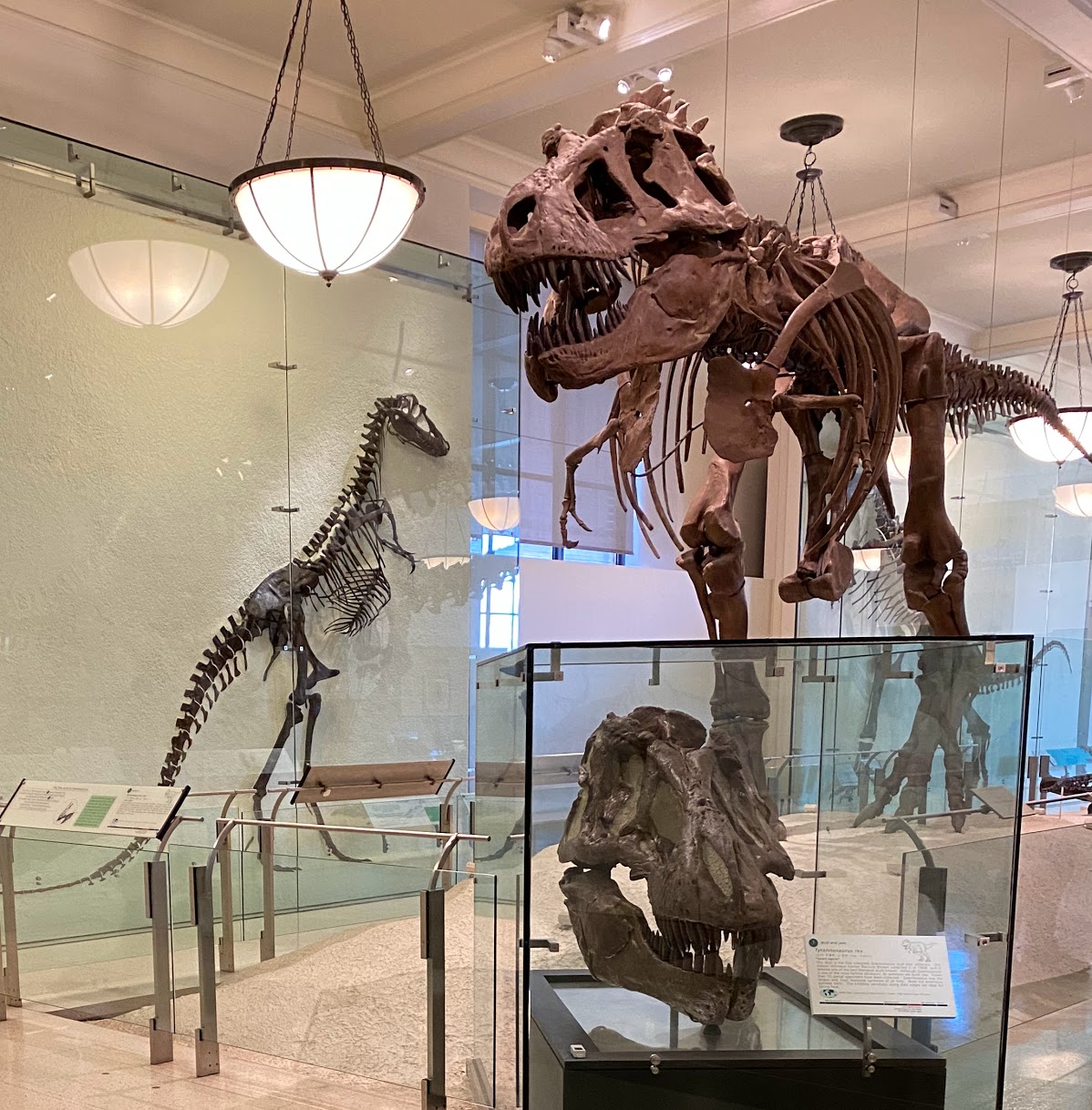
Skeletons in the American Museum of Natural History
In a surprising turn of events, during Thanksgiving Weekend, Christie’s withdrew a valuable Tyrannosaurus rex skeleton from its planned sale. The skeleton was once marketed on the famed auction house’s website as the crown jewel of its Hong Kong sales. But it was removed after a paleontologist revealed that the set of bones up for bid violated copyright protections of replica bones.
To better understand the paleontologist’s claim, it is important to learn a bit about dinosaur skeletons as they appear in museums and on the art market. It is common industry practice to include both original and cosmetic (replica) bones when displaying a dinosaur skeleton. This is because complete dinosaur skeletons are hard to come by and even properly excavated bones are not in pristine condition. This combination of plastic and authentic dino parts acts as the dinosaur’s Instagram filter while on display for her adoring crowd.
Intellectual property rights may be held in the structure of the replica bones. This is what gave rise to Christie’s public withdrawal of the item. A lawyer for the Black Hills Institute of Geological Research in South Dakota contacted Christie’s with concerns that the dinosaur skeleton listed for sale infringed copyright protections held by Black Hills. Black Hills holds the copyrights to replica bones of a T. rex named Stan. Stan’s skeleton was sold by Christie’s in 2020 for a record-breaking $31.8 million. Black Hills currently uses the protections of Stan’s replica bones to make full-size polyurethane casts of the dinosaur. The casts are actually available for purchase for $120,000.
Black Hills’ counsel approached Christie’s after learning that the auction house had planned to sell a T. rex named Shen. Black Hills’ president, a paleontologist named Peter Larson, told CNN that Shen was primarily (“95% or more”) of the same replica bones that comprise Stan. If this were true, not only would selling Shen thus violate Black Hills’ intellectual property rights, but the potential buyer would grossly overpay for the skeleton. The anticipated sticker price for Shen was millions of dollars higher than the measly $120k price of Stan’s polyurethane bones in the Black Hills Institute catalog. It’s easy to see the problem: had Christie’s gone through with the planned sale, the buyer would have been misled into overpaying for a mostly inauthentic and infringing skeleton.
(In fact, this scenario raises questions about the authenticity of the skeleton. If an object is primarily comprised of replica pieces or is the result of extensive alternations or conservations, then should the auction house market list the lot as authentic? These same questions arise in the context of fine art and all collectibles.)
Christie’s panicked, and withdrew the item. However, copyright disputes over replica bones are not the only legal issues that arise when dealing with dinosaur fossils. More commonly, problems stem from the excavation of the bones themselves, and the legality of their sale and export to other countries.
Who collects dinosaurs?
Dinosaur skeletons as décor items are all the rage, the “it” gift to have at home. Take Leonardo DiCaprio, the long-reigning Hollywood A-lister, who made fossil-buying staggering cool by turning his collection of prehistoric skeletal remains into design elements. Agutte’s, Christie’s, and Sotheby’s have all profited from high-profile buyers like DiCaprio, who treat dinosaur skeletons collectibles for their private homes. The draw could be the exorbitant price tag, large size, the storied remains of past millennia, or the limited availability of authentic pieces. These considerations make the practice of collecting dinosaurs a truly exclusive hobby. Apart from DiCaprio, fellow actor Nicolas Cage has been known to partake in unconventional collecting practices, such as amassing his own strange collection of antiquities, including a dinosaur skull. His other purchases include shrunken heads, pygmy heads, two castles in Europe, a nine-foot tall ancient burial tomb, and an octopus. Additionally, he made large real estate purchases to further his real-life search for the Holy Grail, but has admitted that, in doing so, his behavior “got out of hand.” The Rock is also a dinosaur fan, but he steers clear of the real deal. In his home, he has a replica skull (of the aforementioned T. rex Stan). The choice of a replica is not because he couldn’t afford to house real bones in his den. The Rock has stated that he believes dinosaur bones should be in the hands of paleontologists trained to care for them, thus cementing the Rock in America’s heart as the nation’s true national treasure. (Once again, our apologies to Nicolas Cage—we may be moonstruck over your films, but not your collecting practices).
While the Rock has been purchasing replica skulls to preserve fossils for science, Cage and DiCaprio have been duking it out in the auction house. Cage engaged in a massive bidding war with DiCaprio over a 67 million-year-old dinosaur skull – and he won. However, his victory was short lived. Six years later, the Mongolian government demanded the repatriation of the skull under Mongolian law.
Mongolian Law
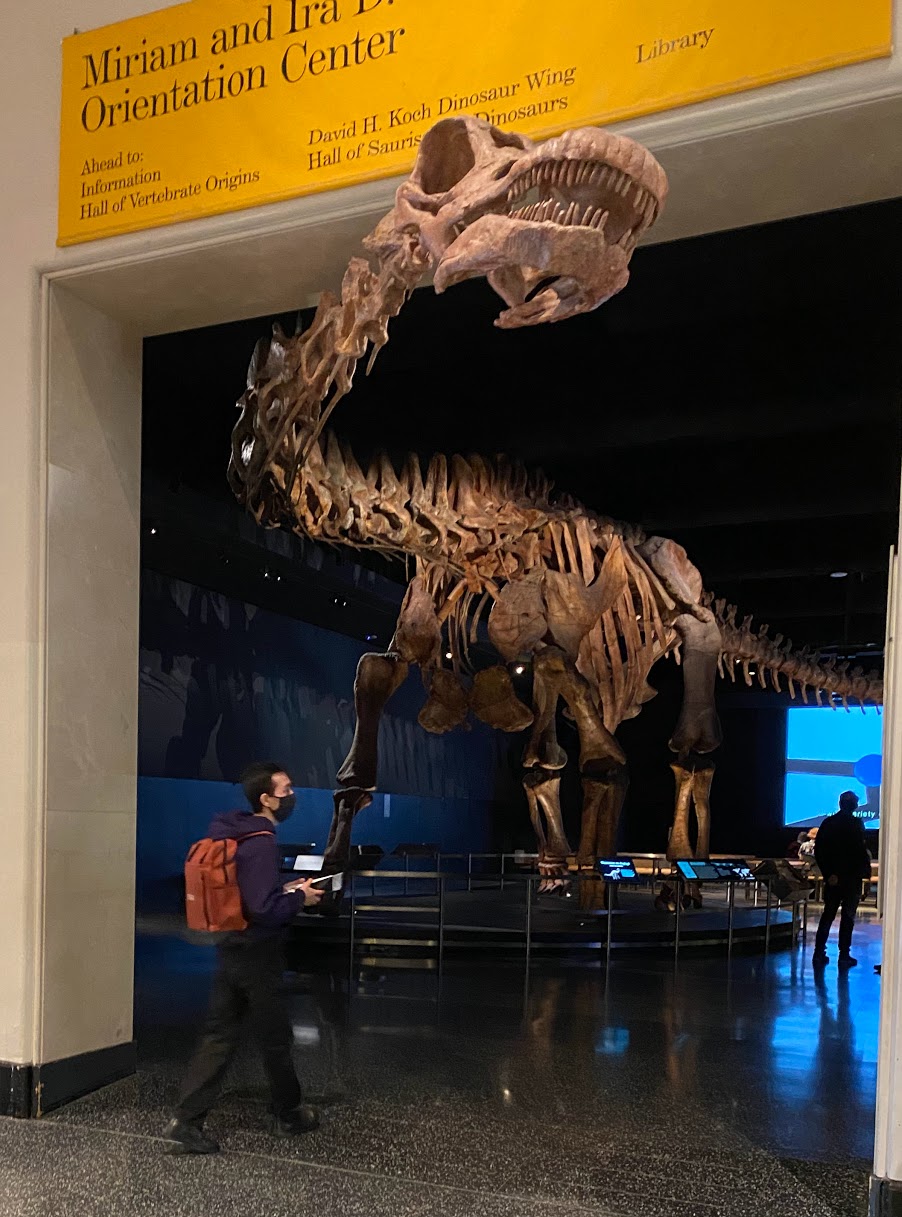
Another impressive skeleton at the American Museum of Natural History
Regulations determining the legality of fossil excavation, trade, and export vary depending on the country in which the specimen was unearthed. Mongolia, for example, enacted a law in 1924 prohibited commercial export of fossils by giving the Mongolian government possession of them when uncovered within Mongolia’s borders. The law then criminalizes anyone who excavates and illegally exports fossils found in places such as the Gobi Desert, which might well be the Coachella of the T. rex, because that’s where all the T. rex skeletons seem to have gathered to party under the sun.
Morocco, Brazil, China, and Argentina all have similar laws which criminalize commercial export of these precious, prehistoric fossilized remains. Consequently, buyers who purchase a dinosaur fossil that has come from one of these areas – without the permission of the relevant government – is in violation of that country’s national law. As a result, they may be required to forfeit the object to its home country.
Mongolia’s stance on fossils as exclusively government property came into the limelight in 2016 when the purchaser of a Tyrannosaurus rex Baatar skull (the “Baatar Skull”) voluntarily returned the skull to the Mongolian government after the true provenance of the skull was proven. The client had purchased the skull from a California auction house in 2007. It appeared legitimate to the buyer at the time of sale because the skull arrived in the U.S. using proper customs documents, and the auction house listed the skull’s origins as being “Eurasian,” which may or may not have signaled its origin as Mongolian. to the buyer to include Mongolia. When Homeland Security Investigations (HSI) looked into the matter in 2015, and their investigation determined that the skull was, in fact, Mongolian, and had entered the country illegally, the buyer forfeited the skull as Mongolian national property.
This example is one of many recent forfeitures of dinosaur remains to their countries of origin. A similar incident occurred just a few years prior to the Baatar Skull’s return, and also involved a Baatar skull from Mongolia (the “Baatar”). In this case, more red flags existed that could have tipped off a prudent buyer to the potentially criminal features of his purchase. The Baatar was illegally exported to the U.S. by making a sneaky pitstop in Britain, which may have distracted customs officials, as the skull did not come directly from the desert. Moreover, the customs documents used to bring the Baatar into the U.S. took a bit of artistic license in their description, relying heavily on vague terms to describe the piece.
When the skull was put up for sale by a Texas auction house Heritage Auctions, Inc. , the Mongolian government recognized the skull as being extremely similar to the species known for being excavated on Mongolian soil. The Asian nation initiated proceedings to stop the auction house from going through with the sale, even receiving a Temporary Restraining Order (TRO) against the house to prevent the auction. Heritage Auctions brazenly ignored the TRO and went through with the sale anyway, simply adding to the listing that the skull’s eventual possession would be determined by the outcome of the Mongolian government’s actions. Astonishingly, the auction house found a buyer game for this very risky gamble of a whooping $1 million.
Following the sale, the skull was proven to be of Mongolian provenience, and actions demanding its return were quickly filed with the U.S. Attorney’s Office, ICE’s Homeland Security Investigations, and the State of Texas. The importance of returning skulls such as the two aforementioned Baatar skulls cannot be glossed over. While the laws may seem extreme in practice, as buyers like Cage lose ownership of their prized treasures, the reality is that these dinosaur bones are not toys; they are irrecoverable pieces of global cultural heritage that must be preserved and studied with unyielding caution and care. As a result, adherence to the regulations of these foreign countries and refraining from purchasing illegally exported fossils, even through channels that seem legal, is vital to protecting the prehistoric legacies of hundreds of dinosaur species.
The same holds true for fossilized remains found on U.S. soil, though the regulations determining the possession of these objects depend on who owns the land from which the fossil was excavated. If the fossil was taken from private land with the permission of the private landowner, the fossil may be bought and sold commercially for profit. If, on the other hand, the fossil was discovered on state or federal land (including on land within national forests and parks), the fossil’s ownership falls under a different set of property regulations that limit its capacity for commercial sale by the finder.
A high-profile case involving dinosaur remains found in U.S. soil occurred in 2006, after Larry Walker, a self-deemed “paleo-prospector”, illegally excavated dinosaur claws from land owned by the government in a desert near his home in Utah. Under the cover of night, Walker added a layer of intrigue to his already mysterious job title by erecting “camouflage netting” over his excavation workspace each night. After successful excavation of the claws – talons belonging to a distinctive prehistoric bird species – Walker then did away with any attempts at subterfuge by publicly selling the claws at an extremely flashy gem and mineral show in Arizona. He walked away with $15,000, feeling flush with fortune. But his luck was about to run out. His big sale was followed by a formal investigation by the government, which let to Walker’s eventual prosecution for his illegal paleo-prospecting ways. Walker was fined $15,000 and sentenced to ten months in jail.
In Walker’s case, he seems the author of his own fate, as his actions demonstrated that he not only knew he was removing the claws from government land, he also knew that his excavation was wrong. However, in some cases involving U.S. fossils, their discovery may be accidental. The average tourist wandering down a trail at national park could feasibly pick up a brown rock that looks like every other brown rock, only to later discover that it is a priceless piece of the land’s history. Should that tourist become aware that the brown rock is a fossil, he or she would be required to forfeit it to the government. Yet, a criminal investigation, like the one that brought down dear Walker the Paleo-Prospector, would be unlikely.
Conclusion
In essence, regulations concerning dinosaur fossils and skeletal remains are no laughing matter and must be respected (the dinosaurs don’t find violation of these laws humerus). If the fossil’s origin is proven to be of a country whose laws dictate national possession, it is likely that the buyer of such a fossil will be required to forfeit the object back to its home country. If the fossil is of U.S. origin, a buyer or finder may possess it, if it is excavated with the permission of a private land owner. Otherwise, that fossil will be property of the government, and will likely need to be forfeited as well. Either way, the find should be reported.
The justification for these seemingly strict laws is that the delicacy and rarity of fossilized dinosaur remains requires them to be handled and preserved by professionals. Although these laws may seem stringent, they protect the legacy of the entire planet. Moreover, new dinosaur species continue to be found in areas rich with dinosaur artifacts. An example occurred as recently as last week, with the discovery of the world’s first “swimming dinosaur”. The Natovenator is the first non-avian dinosaur with swimming and diving capabilities to be discovered. Its remains were found in Mongolia. Such discoveries heighten the need for regulations protecting the excavation of dinosaur remains to be followed, because the scientific community requires the information encased in them to further ongoing scholastic research.
So if you plan on gifting fossils this holiday season, be aware of the risks. Take a page out of the Rock’s book, and make sure they’re appropriately-priced replicas.
by Amineddoleh & Associates LLC | May 31, 2022 |
Each May, the art world buzzes as art fairs hit New York City and the major auction houses host blockbuster international sales. After scaling back in 2020 and 2021 due to the Covid-19 pandemic, the art scene returned with gusto this spring. Even the Financial Times noted that New York’s 2022 auction season wrapped up “strongly,” after a series of record-breaking successes.

Shot Sage Blue Marilyn (courtesy of Christie’s)
Christie’s made headlines during its Spring Marquee Week when Andy Warhol’s “iconic portrait of Marilyn Monroe,” Shot Sage Blue Marilyn, sold to Larry Gagosian for a little over $195 million after just 4 minutes of bidding. This was the second-highest result for an artwork at auction, and the highest price ever paid for a work by an American artist. Notably, Gagosian had previously sold the work to Thomas Ammann in 1986, so the work is returning to its prior seller almost forty years later. (It is unclear whether Gagosian is keeping Marilyn for his own collection or whether he purchased it on behalf of a client.) Overall, the sale attracted bidders from 29 different countries and 68% of lots sold above their respective high estimates, demonstrating that collectors have not lost their appetite for contemporary art over the past two years. Works by six other artists, including Francesco Clemente and Ann Craven also sold for record prices while Cy Twombly and Robert Ryman occupied the top lots after Warhol. Christie’s Chairman of 20th and 21st Century Art, Alex Rotter, commented that this was a “historic night” and “a testament to the strength, the vibrancy, and the overall excitement of the art market today.”
Sotheby’s spring sales also broke records, with the second half of the Macklowe Collection up for grabs. Achieving a total of $922 Million, the Macklowe Collection won the distinction of becoming the most valuable collection ever sold at auction. The group of 65 works, including exemplars by Rothko, Warhol, Giacometti, and de Kooning, was sold during two separate auctions in the fall and spring (the first on November 15, 2021, and the second on May 16, 2022), driving up interest. The collection was formed by Harry B. Macklowe and his ex-wife Linda over the many decades of their marriage. In 2018, amidst acrimonious divorce proceedings and widely varying appraisals over the collection’s actual value, a New York State Supreme Court judge ordered the couple to sell the artworks and split the profits equally. Although the auctions were delayed due to Covid-19, it was well worth the wait.
 Finally, a third big auction house player made headlines for astronomical prices this spring. Phillips’ superstar was an untitled work by Jean-Michel Basquiat. The acrylic and spray paint on canvas from 1982 was estimated to sell for $70 million, but it surpassed expectations and brought in $85 million during an evening sale on May 18, 2022. The seller, Japanese mogul Yusaku Maezawa, had originally purchased the 16-foot-long work in 2016 for $57.3 million. Basquiat is currently enjoying a resurgence in popularity among both established and younger art collectors, with another work selling for $40 million last November.
Finally, a third big auction house player made headlines for astronomical prices this spring. Phillips’ superstar was an untitled work by Jean-Michel Basquiat. The acrylic and spray paint on canvas from 1982 was estimated to sell for $70 million, but it surpassed expectations and brought in $85 million during an evening sale on May 18, 2022. The seller, Japanese mogul Yusaku Maezawa, had originally purchased the 16-foot-long work in 2016 for $57.3 million. Basquiat is currently enjoying a resurgence in popularity among both established and younger art collectors, with another work selling for $40 million last November.
Artsy noted that the 20th-century and contemporary art auctions reflect a “shift in collector’s interests across the board with women artists, artists of color, and emerging artists receiving both critical interest and incredible financial interest.” The staggering results for some of these artists (often realizing much larger amounts their high estimates) may be the result of collectors seeking to purchase works by artists with potentially long and successful careers whose values may further increase. Several news sources noted that one of the stars in this field is Anna Weyant. The 27-year-old Canadian had her works sold at the three major auction houses (Sotheby’s, Christie’s, and Phillips) and high-profile galleries. Her work, “between sweet and sour, beautiful and foreboding” has surged in price and interest across the board.
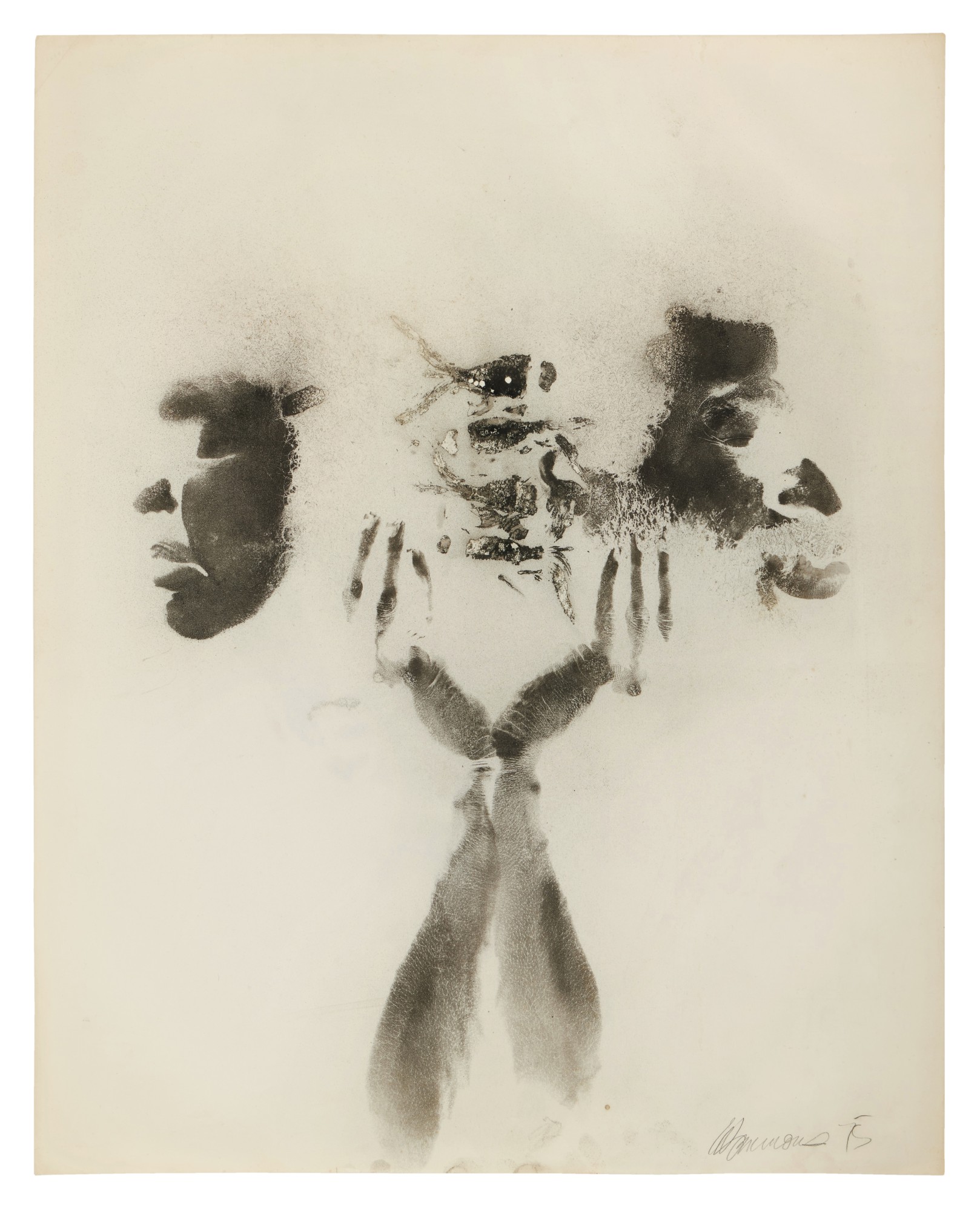 We were pleased to represent a number of collectors consigning important works at auction this spring. One of our clients is the collecting family that consigned three works by David Hammons for the Sotheby’s Contemporary Evening Auction on May 19. Sotheby’s touted these works and their provenance, after the paintings remaining with our clients for nearly five decades. All three of the works performed well, with two of them selling for above their high estimates. (The combined high estimate of the 3 works was $2.3 million, and they actually realized $2.6 million.)
We were pleased to represent a number of collectors consigning important works at auction this spring. One of our clients is the collecting family that consigned three works by David Hammons for the Sotheby’s Contemporary Evening Auction on May 19. Sotheby’s touted these works and their provenance, after the paintings remaining with our clients for nearly five decades. All three of the works performed well, with two of them selling for above their high estimates. (The combined high estimate of the 3 works was $2.3 million, and they actually realized $2.6 million.)
It is always gratifying to work with clients and help them achieve the best outcomes for the sale of artwork. We look forward to a continued season of strong art market sales and new and exciting artists as summer approaches.
by Amineddoleh & Associates LLC | Jan 19, 2022 |
Like other nations rich in archaeological material, Mexico has suffered a great deal of looting and illegal export of its cultural heritage over the past decades. Despite enacting protective legislation dating back to the late 19th century, cultural heritage objects from Mexico continue to be smuggled out of the country and sold on the open market. These items, many of which hail from pre-Columbian indigenous societies such as the Maya and Aztec, are highly prized by museums and private collectors alike. Stelae (free-standing commemorative monuments erected in front of pyramids or temples and made from limestone), polychrome vessels, jade and gold funerary masks, stone altars, and sculptured figurines are among the many types of objects offered for sale. This is a profitable business worldwide; according to Sotheby’s, its auctions of these items have reached nearly $45 million over the past 15 years. (One of our previous blog posts details the theft of pre-Columbian antiquities worth over $20 million from Mexico’s National Museum of Archaeology on Christmas Day 1985, and how authorities recovered them 3 years later.)
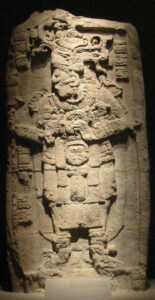
Pre-Colombian Stelea
Photo Credit: National Museum of Anthropology in Mexico City.
In light of these circumstances, Mexico has recently taken several concrete steps to strengthen efforts to track down and recover cultural and historical artifacts. In 2011, the National Institute for Anthropology and History (NIAH) announced the launch of a new unified database for cultural property, which allows for the inscription of cultural goods from anywhere within Mexico. Each item in the database is provided with a unique ID number and accompanying details (such as type, material, dimensions, and provenance), resulting in a publicly accessible and standardized system. This is an invaluable tool that will aid the government in protecting the country’s approximately 2 million movable artifacts.
Mexico has also implemented measures to further protect heritage items already removed from within its borders. In March 2013, the governments of Mexico, Guatemala, Costa Rica, and Peru contested the sale of pre-Columbian art from the Barbier-Mueller Museum at Sotheby’s Paris. All these countries have similar laws vesting ownership of antiquities in the State; therefore, they alleged that the sale was illegal because the objects were not accompanied by export licenses or sufficient provenance information confirming that the works were removed prior to the passage of the relevant laws. Nonetheless, the sale went ahead as planned. A French diplomat stated that the items did not appear on the Interpol database or ICOM Red List, and as such were not considered looted or stolen. (This statement was made even though pre-Columbian antiquities are underrepresented on both lists.) Ultimately, nearly half of the lots failed to sell, and the total sales proceeds fell far below the pre-sale estimate. Public pressure may have played a role in staving off bidders.
Despite this controversy, auctions of similar items have continued. In September 2019, Mexico and Guatemala jointly denounced the auction of pre-Columbian artifacts at French auction house Drouot. The auction house claimed the sale was “perfectly legitimate” and proceeded to sell 93% of the lots, netting $1.3 million for the sale. In response, the consigner, Alexandre Millon, stated that he was a victim of “opportunistic cultural nationalism.” This stoked further tension among countries of origin and market countries.
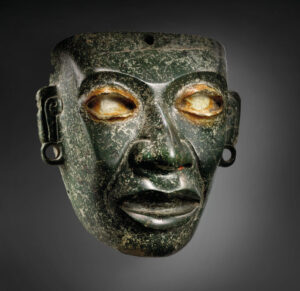
Teotihuacan mask, ca. 450–650
Photo Credit: Christie’s
In February 2021, NIAH lodged a formal legal claim against Christie’s over the sale of 33 pre-Columbian objects, including a stone sculpture of the goddess of fertility Cihuatéotl estimated at $722,000-$1.08 million and a Teotihuacán green stone mask of Quetzalcóatl estimated at $420,000-$662,000. Notably, the mask previously belonged to French dealer Pierre Matisse, son of artist Henri Matisse. While Christie’s maintained that it was confident in the legitimate provenance of the items, historian and archaeologist Daniel Salinas Córdova indicated that the circumstances under which the items had left their places of origin was still unclear. He reiterated that auctioning pre-Columbian antiquities is dangerous because it “promote[s] the commercialization and privatization of cultural heritage, prevent[s] the study, enjoyment, and dissemination of the artifacts, and promote[s] archaeological looting.” Although the sale proceeded and the legal claim has not yet been resolved, Mexico continues to enforce its patrimonial rights.
In September 2021, ambassadors from 8 Latin American Countries (Mexico, Bolivia, Costa Rica, Colombia, Ecuador, Guatemala, Panama, and Peru) banded together to stop an auction of pre-Columbian artifacts in Germany. Mexican Secretary of Culture Alejandra Faustro sent a letter to the Munich-based dealer, Gerhard Hirsch Nachfolger, citing Mexico’s 1934 patrimony law and reiterating the government’s commitment to recovering its cultural heritage. Mexico’s ambassador to Germany, Francisco Quiroga, even visited the auction house in person in an attempt to block the sale. A complaint was also filed with the Attorney General’s Office in Mexico. The auction took place, but of the 67 pieces identified as being Mexican, only 36 sold. Notably, one of the highlights – an Olmec mask with an estimate of €100,000 – did not achieve the reserve price.
That same month, Mexico announced the creation of a new team composed of National Guard personnel tasked with the recovery of stolen archaeological pieces and historical documents. The nation’s president, Andres Manuel Lopez Obrador, credited Italy with the idea. He stated, “Italy has a special body to recover stolen archaeological pieces. We are going to follow that example, I have given the instruction for the National Guard to constitute a special team for the purpose,” Lopez Obrador said.
As recently as November 2021, the Mexican government issued a letter questioning the legality of two auctions in Paris (at Artcurial and Christie’s) selling pre-Columbian objects. Embassy officials and the Mexican Secretary of Culture asked for the sales to be halted on the grounds that they “stri[p] these invaluable objects of their cultural, historical and symbolic essence, turning them into commodities or curiosities by separating them from the anthropological environment from which they come.” Only a few months earlier (in July), the governments of Mexico and France had signed a Declaration of Intent on the Strengthening of Cooperation against Illicit Trafficking in Cultural Property, which was meant to signal a recommitment towards the restitution and protection of each nation’s cultural heritage. Although Mexican officials appealed to UNESCO, bidding opened as scheduled on Artcurial’s online platform (with lots priced at $231-$11,600) and Christie’s earned over $3.5 million in its own sale. The day before the Christie’s sale, the embassies of Mexico, Colombia, Guatemala, Honduras, and Peru in France issued a joint statement decrying the “commercialization of cultural property” and “the devastation of the history and identity of the peoples that the illicit trade of cultural property entails.”
Nonetheless, Mexico’s persistence has borne fruit. In September 2021, it was able to halt the sale of 17 artifacts at a Rome-based auction house. The Carabinieri TPC seized the objects after an inspection revealed that they had been illegally exported, and returned them to Mexico in October. The successful recovery of these objects demonstrates the importance of international cooperation. Many governments’ resources are stretched thin policing their own borders for cultural heritage smuggling and theft, and therefore greatly benefit from assistance by foreign law enforcement. It is also an example of how successful cultural diplomacy can be in the recovery of such objects.
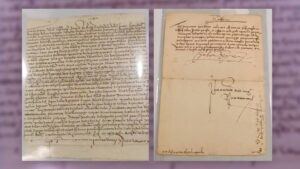
The letter signed by Hernán Cortés recovered by the Mexican authorities.
Photo Credit: The National Archives
In addition to law enforcement and government agencies, laypeople have a crucial part to play in the recovery of looted or illegally exported artifacts. For instance, a group of academics in Mexico and Spain helped thwart the sale of a 500-year-old letter linked to conquistador Hernán Cortés. The letter, dating back to 1521, had been offered for sale by Swann Galleries in New York in September 2021. It was expected to fetch $20,000-$30,000. By searching online catalogues of global auction houses and a personal trove of photographs depicting Spanish colonial documents, the group traced the letter’s provenance to the National Archive of Mexico (NAM), a UNESCO World Heritage Site. An image of the letter had been taken by a Mormon genealogy project, which provided supporting evidence. Furthermore, the group unearthed 9 additional documents linked to Cortés that had been sold at auction – including at Bonhams and Christie’s – between 2017 and 2020. One of these had been sold previously at Swann Galleries for $32,500 and later displayed at the Morgan Library & Museum in New York as part of an exhibition. It was confirmed that all the documents had been stolen from the NAM – they were surgically excised from books – and illegally exported. In response, Swann Galleries cancelled the planned auction. The purchaser of the aforementioned letter returned it in good faith to the auction house. Mexico’s Foreign Ministry enlisted the help of the US Department of Justice to repatriate the 10 manuscripts, in cooperation with the Manhattan District Attorney’s Office and Homeland Security Investigations. The manuscripts were formally handed over in September 2021.

 Our founder, Leila Amineddoleh, has recently been featured in New York Metro Super Lawyers Magazine, alongside other leaders in her field. Leila was chosen for the piece as a top-rated intellectual property, art, and cultural heritage lawyer well-known in the industry for getting the job done right. This means advocating both for her clients, and for the art and cultural heritage at issue.
Our founder, Leila Amineddoleh, has recently been featured in New York Metro Super Lawyers Magazine, alongside other leaders in her field. Leila was chosen for the piece as a top-rated intellectual property, art, and cultural heritage lawyer well-known in the industry for getting the job done right. This means advocating both for her clients, and for the art and cultural heritage at issue.


 Finally, a third big auction house player made headlines for astronomical prices this spring. Phillips’ superstar was an untitled work by Jean-Michel Basquiat. The acrylic and spray paint on canvas from 1982 was estimated to sell for $70 million, but it surpassed expectations and brought in
Finally, a third big auction house player made headlines for astronomical prices this spring. Phillips’ superstar was an untitled work by Jean-Michel Basquiat. The acrylic and spray paint on canvas from 1982 was estimated to sell for $70 million, but it surpassed expectations and brought in  We were pleased to represent a number of collectors consigning important works at auction this spring. One of our clients is the collecting family that consigned three works by David Hammons for the Sotheby’s Contemporary Evening Auction on May 19. Sotheby’s
We were pleased to represent a number of collectors consigning important works at auction this spring. One of our clients is the collecting family that consigned three works by David Hammons for the Sotheby’s Contemporary Evening Auction on May 19. Sotheby’s 

